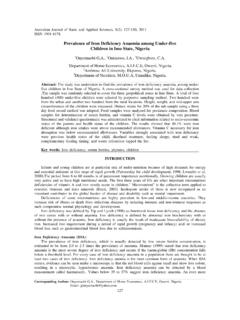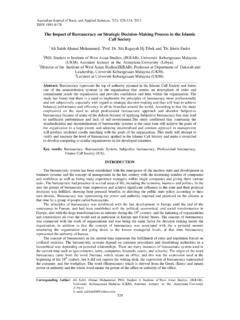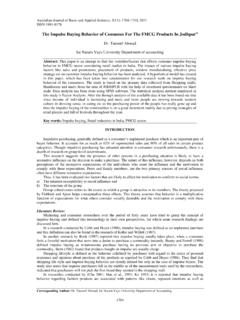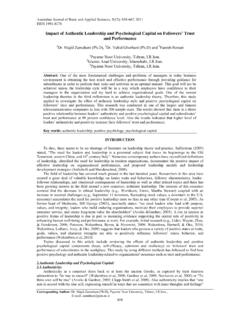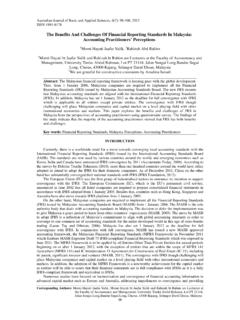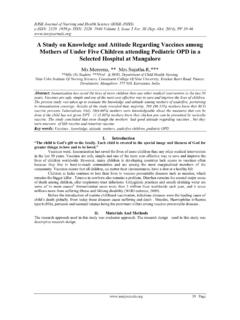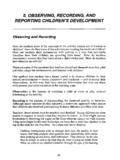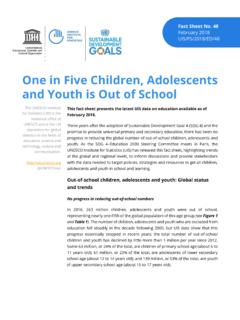Transcription of ANAEMIA PREVALENCE AMONG UNDER-FIVE CHILDREN IN …
1 Australian Journal of Basic and Applied Sciences, 5(2): 122-126, 2011 ISSN 1991-8178 ANAEMIA PREVALENCE AMONG UNDER-FIVE CHILDREN in Imo State, Nigeria Onyemaobi, and Onimawo, Alvan Ikoku Federal College of Education, Owerri, Imo State, Nigeria. Ambrose Alli University, Ekpoma, Edo State, : A cross-sectional study of CHILDREN aged 6-60 months was carried out in nine LocalGovernment Areas (LGAs). A total of four hundred (400) UNDER-FIVE CHILDREN were selected bypurposive sampling method. Two hundred were from the urban and another two hundred from therural locations. Height, weight, and mid-upper arm circumferences of the CHILDREN were 3-day food record for 20% of the sub sample was analyzed for proximate samples for determination of haemoglobin (Hb), packed cell volume (PCV), and vitamin Clevels were obtained by vein puncture.
2 Stool samples were collected to determine parasitic and validated questionnaire was administered to elicit information related to socio-economicstatus of the parents and health status of the CHILDREN . Statistical analysis was done using SPSS/PC(version 13), level of significance taken as P< The results showed of under -fives wereanaemic and were iron deficient. Vitamin C necessary for iron absorption was belowrecommended allowances. ANAEMIA was prevalent in both rural and urban locations; however it wasmore in rural settings. Educational levels of parents, mosquito bites, child s size and appearanceratings, and vitamin/mineral drops consumption were the socio-economic factors associated withprevalence of ANAEMIA .
3 Based on these findings high premium for nutrition of mothers is words: ANAEMIA , UNDER-FIVE CHILDREN , haemoglobin, PREVALENCE , is a pathologic deficiency in oxygen-carrying haemoglobin in red blood cells (Rosenbaum, 2004).It is one of the micronutrient deficiencies that affect both developed and developing nations UNDER-FIVE CHILDREN (Wardlaw et al. 2004; FAO/WHO, 1992). ANAEMIA results when the haemoglobin level is significantlydepressed to result in a haemoglobin or haematocrit below the 90% or 95% of the range of a healthy referencesample of the same age and sex (Bowman and Russel, 2001). ANAEMIA is the best known manifestation of irondeficiency.
4 It retards physical and cognitive development, and affects about two billion people worldwide(Black, 2003). Iron deficiency affects CHILDREN under five years of age more than any other group. This isbecause iron stores are exhausted between 4 months and 6 months after which the child needs ironsupplementation in the diet (Domellof et al, 2001). During the period from birth to two years, the growth rateis high, and so is the need for nutrients. The need for food and good nourishment is increased for the UNDER-FIVE to support the rapid growth and development. When nutrients are limiting at this critical phase, growthslows down and may even stop.
5 Unfortunately, more than half of the CHILDREN in developing countries are iron-deficient in critical stages of brain development. This occurs between 6 and 24 months (UNICEF, 2004;Maziya-Dixon et al, 2004; Baker, 2007).In developing countries, about one-third of the CHILDREN less than five years of age are short andunderweight for their ages (Weigley et al, 2003). under nutrition is at the heart of the problem. To grow, thechildren need to consume adequate amounts of energy, protein, calcium, iron, zinc and other nutrients. Solidfoods are given to CHILDREN at about 6 months of age. These would supply the needed extra iron for thegrowing child.
6 Failure to provide the extra nutrients precipitates deficiency of essential micronutrients prevalent AMONG CHILDREN in developing countries, including Nigeria. under nourished under -fives are unable to learnand this is carried to adult life. One of the most devastating to under -fives is micro nutrient deficiency of iron. The brain, central nervous system and immune systems are all affected when the under -fives are irondeficient (Fredrickson,2000). Other effects include stunting, wasting and underweight which have beendocumented severally (Schrimpton, 1992; Caulfield et al, 2006; Stoltfzfus et al, 2004; Ibe, 2002). To determineCorresponding Author:Onyemaobi , Alvan Ikoku Federal College of Education, Owerri, Imo State, : J.
7 Basic & Appl. Sci., 5(2): 122-126, 2011the state of UNDER-FIVE CHILDREN in relation to the above factors, this study focused on assessment of prevalenceof ANAEMIA AMONG UNDER-FIVE CHILDREN in Imo State of AND METHODSThis study was done in Imo State, Nigeria using information from the socio-economic characteristics of UNDER-FIVE parents, health status of mother during pregnancy, health status of UNDER-FIVE CHILDREN , breastfeeding/weaning-dietary habits, health facilities/sanitary practices, nutrition knowledge of parent. Anthropometricmeasurements of under -5s- weight (kg), height (cm), and mid-upper arm circumference (cm.) were assessments using blood specimens (2ml) tested for Haemoglobin levels Haematocrit (PCV) levelAscorbic acid (vitamin C) level.
8 Stool samples were collected to check for worm (helminthes) infestation. Foodrecords which involved weighing of actual foods consumed by under -fives for three consecutive days, includingone day weekend were taken. The samples of meals consumed were analyzed in the laboratory to find outtheir energy (kcal), protein (gm), fat (gm), carbohydrate (gm), iron (mg), and ascorbic acid (mg). Statisticalanalysis was done using Statistical Package For Social Sciences version 13 (SPSS/PC).Significance level was P< AND DISCUSSION The results showed that the overall mean haemoglobin of the subjects investigated (n=400) aged 12-60months was Figure 1 shows the PREVALENCE of ANAEMIA using haemoglobin (Hb) levels of thechildren.
9 AMONG the surveyed CHILDREN (n=400), were normal and were of varying degrees ofanaemia. Using the WHO/UNICEF/UNN (2001) classification had mild ANAEMIA , were moderatelyanaemic and was severely anaemic (Fig. 1). The PREVALENCE of ANAEMIA ( ) in Imo State was higherthan the WHO (2007) estimated 40% for South East Asia and Sub-Saharan Africa. However, because therewere no fixed figures for all countries, the PHNI (2003) statistics reported the PREVALENCE of ANAEMIA in manyWHO countries of the world. For example, in Ghana (1999) the PREVALENCE was 84%, Mali was forchildren 6-59 months in 2001.
10 Gambia had 76% for 1-5years which was higher than that of the present studies in African countries and Southern Asia confirmed high PREVALENCE of ANAEMIA as observed The PREVALENCE in India was for CHILDREN 6-35 months; Nepal had 78% for CHILDREN 6-59months in 1997 and 70% in 1998. In Kazakhstan (1995) it was for CHILDREN 0-23 months and CHILDREN more than 3 years. In Eastern Mediterranean, ANAEMIA PREVALENCE was 70% of pre-school CHILDREN (PHNI, 2003).These results confirmed that in South East Asia and Sub-Saharan Africa the PREVALENCE was , in developed countries, the figures fell below 30% for instance in Mexico (1999) it was inchildren 6-23 months and in CHILDREN 6-59 months.
